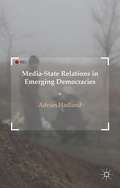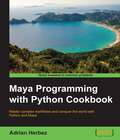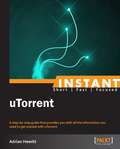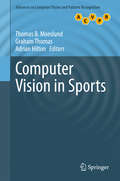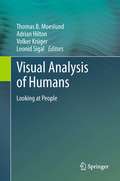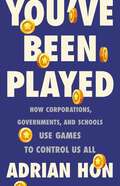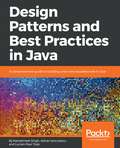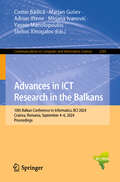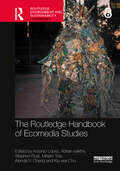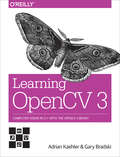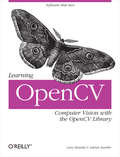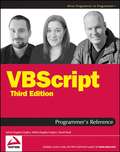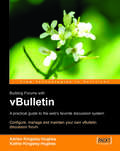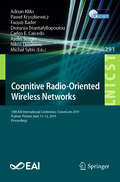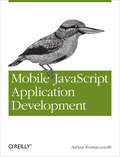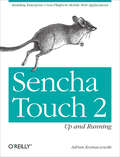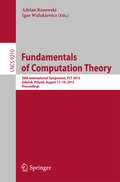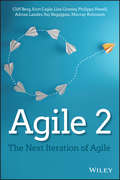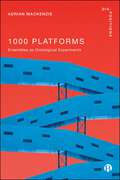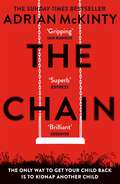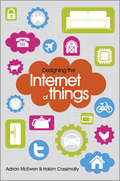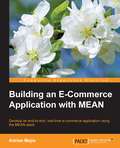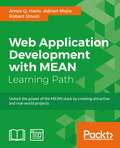- Table View
- List View
Media�State Relations in Emerging Democracies
by Adrian HadlandThe news media and the state are locked in a battle of wills in the world's emerging democratic states. It is a struggle that will determine whether or not democracy flourishes or withers in the 21st century. Using a number of case studies, including South Africa, this book evaluates what is at stake.
Maya Programming with Python Cookbook
by Adrian HerbezMaster complex workflows and conquer the world with Python and Maya About This Book * Improve your modelling skills and reduce your scripting problems using Python in Maya * Learn to communicate with web applications using Python for easier team development * A quick and practical answer to every problem you can have whilst scripting in Maya with Python Who This Book Is For This book is for Python developers who have just started scripting with Maya. What You Will Learn * Find out how to use Python scripting to automate tedious tasks * Create functional user interfaces to make scripts easy to share with others * Add new functionality to Maya via the power of scripting * Import and export arbitrary data into and out of Maya * Improve your workflow, and that of your team * Create custom create custom controls to make rigs that are easy to work with * Implement a system to render 3D assets for isometric games * Use script jobs to trigger actions automatically in response to user interaction * Open a command port to allow other applications to communicate with Maya In Detail Maya is a 3D graphics and animation software, used to develop interactive 3D applications and games with stupendous visual effects. The Maya Programming with Python Cookbook is all about creating fast, powerful automation systems with minimum coding using Maya Python. With the help of insightful and essential recipes, this book will help you improve your modelling skills. Expand your development options and overcome scripting problems encountered whilst developing code in Maya. Right from the beginning, get solutions to complex development concerns faced when implementing as parts of build. Style and approach This book is comprised of a set of practical recipes, grouped under specific topics, which can be referred to independently or in sequence. These recipes provide quick solutions to common problems, and cover most of the real-world scenarios that developers are likely to face when working with Maya.
Instant uTorrent
by Adrian HewittGet to grips with a new technology, understand what it is and what it can do for you, and then get to work with the most important features and tasks.This book takes a practical, hands-on approach to installing and using uTorrent.This book is great for tech-savvy users who are familiar with network basics and who are looking for an easy-to-follow guide to the BitTorrent technology using uTorrent as the program of choice.
Computer Vision in Sports (Advances in Computer Vision and Pattern Recognition)
by Graham Thomas Thomas B. Moeslund Adrian HiltonThe first book of its kind devoted to this topic, this comprehensive text/reference presents state-of-the-art research and reviews current challenges in the application of computer vision to problems in sports. Opening with a detailed introduction to the use of computer vision across the entire life-cycle of a sports event, the text then progresses to examine cutting-edge techniques for tracking the ball, obtaining the whereabouts and pose of the players, and identifying the sport being played from video footage. The work concludes by investigating a selection of systems for the automatic analysis and classification of sports play. The insights provided by this pioneering collection will be of great interest to researchers and practitioners involved in computer vision, sports analysis and media production.
Visual Analysis of Humans
by Leonid Sigal Thomas B. Moeslund Volker Krüger Adrian HiltonThis unique text/reference provides a coherent and comprehensive overview of all aspects of video analysis of humans. Broad in coverage and accessible in style, the text presents original perspectives collected from preeminent researchers gathered from across the world. In addition to presenting state-of-the-art research, the book reviews the historical origins of the different existing methods, and predicts future trends and challenges. Features: with a Foreword by Professor Larry Davis; contains contributions from an international selection of leading authorities in the field; includes an extensive glossary; discusses the problems associated with detecting and tracking people through camera networks; examines topics related to determining the time-varying 3D pose of a person from video; investigates the representation and recognition of human and vehicular actions; reviews the most important applications of activity recognition, from biometrics and surveillance, to sports and driver assistance.
You've Been Played: How Corporations, Governments, and Schools Use Games to Control Us All
by Adrian HonHow games are being harnessed as instruments of exploitation—and what we can do about it Warehouse workers pack boxes while a virtual dragon races across their screen. If they beat their colleagues, they get an award. If not, they can be fired. Uber presents exhausted drivers with challenges to keep them driving. China scores its citizens so they behave well, and games with in-app purchases use achievements to empty your wallet.Points, badges, and leaderboards are creeping into every aspect of modern life. In You&’ve Been Played, game designer Adrian Hon delivers a blistering takedown of how corporations, schools, and governments use games and gamification as tools for profit and coercion. These are games that we often have no choice but to play, where losing has heavy penalties. You&’ve Been Played is a scathing indictment of a tech-driven world that wants to convince us that misery is fun, and a call to arms for anyone who hopes to preserve their dignity and autonomy.
Design Patterns and Best Practices in Java: A comprehensive guide to building smart and reusable code in Java
by Kamalmeet Singh Adrian Ianculescu Lucian-Paul TorjeCreate various design patterns to master the art of solving problems using Java Key Features This book demonstrates the shift from OOP to functional programming and covers reactive and functional patterns in a clear and step-by-step manner All the design patterns come with a practical use case as part of the explanation, which will improve your productivity Tackle all kinds of performance-related issues and streamline your developmentBook DescriptionHaving a knowledge of design patterns enables you, as a developer, to improve your code base, promote code reuse, and make the architecture more robust. As languages evolve, new features take time to fully understand before they are adopted en masse. The mission of this book is to ease the adoption of the latest trends and provide good practices for programmers.We focus on showing you the practical aspects of smarter coding in Java. We'll start off by going over object-oriented (OOP) and functional programming (FP) paradigms, moving on to describe the most frequently used design patterns in their classical format and explain how Java’s functional programming features are changing them.You will learn to enhance implementations by mixing OOP and FP, and finally get to know about the reactive programming model, where FP and OOP are used in conjunction with a view to writing better code. Gradually, the book will show you the latest trends in architecture, moving from MVC to microservices and serverless architecture. We will finish off by highlighting the new Java features and best practices. By the end of the book, you will be able to efficiently address common problems faced while developing applications and be comfortable working on scalable and maintainable projects of any size.What you will learn Understand the OOP and FP paradigms Explore the traditional Java design patterns Get to know the new functional features of Java See how design patterns are changed and affected by the new features Discover what reactive programming is and why is it the natural augmentation of FP Work with reactive design patterns and find the best ways to solve common problems using them See the latest trends in architecture and the shift from MVC to serverless applications Use best practices when working with the new featuresWho this book is forThis book is for those who are familiar with Java development and want to be in the driver’s seat when it comes to modern development techniques. Basic OOP Java programming experience and elementary familiarity with Java is expected.
Advances in ICT Research in the Balkans: 10th Balkan Conference in Informatics, BCI 2024, Craiova, Romania, September 4-6, 2024, Proceedings (Communications in Computer and Information Science #2391)
by Mirjana Ivanović Yannis Manolopoulos Costin Bădică Marjan Gušev Adrian Iftene Stelios XinogalosThis book constitutes the refereed proceedings of the 10th Balkan Conference in Informatics on Advances in ICT Research in the Balkans, BCI 2024, held in Craiova, Romania, during September 4-6, 2024. The 23 full papers included in this book were carefully reviewed andselected from 31 submissions. They were organized in topical sections as follows: Data Mining and Machine Learning; Software and Systems; Languages and Text; Learning Issues; Distributed Systems; Medical and Health Issues; Web Issues and Tools; Security and Privacy.
The Routledge Handbook of Ecomedia Studies (Routledge Environment and Sustainability Handbooks)
by Miriam Tola Stephen Rust Adrian Ivakhiv Alenda Y. Chang Antonio López Kiu-Wai ChuThe Routledge Handbook of Ecomedia Studies gathers leading work by critical scholars in this burgeoning field. Redressing the lack of environmental perspectives in the study of media, ecomedia studies asserts that media are in and about the environment, and environments are socially and materially mediated. The book gives form to this new area of study and brings together diverse scholarly contributions to explore and give definition to the field. The Handbook highlights five critical areas of ecomedia scholarship: ecomedia theory, ecomateriality, political ecology, ecocultures, and eco-affects. Within these areas, authors navigate a range of different topics including infrastructures, supply and manufacturing chains, energy, e-waste, labor, ecofeminism, African and Indigenous ecomedia, environmental justice, environmental media governance, ecopolitical satire, and digital ecologies. The result is a holistic volume that provides an in-depth and comprehensive overview of the current state of the field, as well as future developments. This volume will be an essential resource for students, educators, and scholars of media studies, cultural studies, film, environmental communication, political ecology, science and technology studies, and the environmental humanities.
The Routledge Handbook of Ecomedia Studies (Routledge Environment and Sustainability Handbooks)
by Miriam Tola Stephen Rust Adrian Ivakhiv Alenda Y. Chang Antonio López Kiu-Wai ChuThe Routledge Handbook of Ecomedia Studies gathers leading work by critical scholars in this burgeoning field. Redressing the lack of environmental perspectives in the study of media, ecomedia studies asserts that media are in and about the environment, and environments are socially and materially mediated.The book gives form to this new area of study and brings together diverse scholarly contributions to explore and give definition to the field. The Handbook highlights five critical areas of ecomedia scholarship: ecomedia theory, ecomateriality, political ecology, ecocultures, and eco-affects. Within these areas, authors navigate a range of different topics including infrastructures, supply and manufacturing chains, energy, e-waste, labor, ecofeminism, African and Indigenous ecomedia, environmental justice, environmental media governance, ecopolitical satire, and digital ecologies. The result is a holistic volume that provides an in-depth and comprehensive overview of the current state of the field, as well as future developments.This volume will be an essential resource for students, educators, and scholars of media studies, cultural studies, film, environmental communication, political ecology, science and technology studies, and the environmental humanities.The Open Access version of this book, available at www.taylorfrancis. com, has been made available under a Creative Commons Attribution-Non Commercial-No Derivatives (CC-BY-NC-ND) 4.0 license. Deep gratitude for the generous support of those institutions that provided funding to enable this volume to be available simultaneously in print and open access: University of Oregon Libraries Open Access Publishing Award, Frank J. Guarini School of Busi-ness at John Cabot University, University of Vermont Humanities Center, University of California Santa Barbara, University of Lausanne, and School of Humanities at Nanyang Technological University.
Learning OpenCV 3: Computer Vision in C++ with the OpenCV Library
by Gary Bradski Adrian KaehlerGet started in the rapidly expanding field of computer vision with this practical guide. Written by Adrian Kaehler and Gary Bradski, creator of the open source OpenCV library, this book provides a thorough introduction for developers, academics, roboticists, and hobbyists. You’ll learn what it takes to build applications that enable computers to "see" and make decisions based on that data.With over 500 functions that span many areas in vision, OpenCV is used for commercial applications such as security, medical imaging, pattern and face recognition, robotics, and factory product inspection. This book gives you a firm grounding in computer vision and OpenCV for building simple or sophisticated vision applications. Hands-on exercises in each chapter help you apply what you’ve learned.This volume covers the entire library, in its modern C++ implementation, including machine learning tools for computer vision.Learn OpenCV data types, array types, and array operationsCapture and store still and video images with HighGUITransform images to stretch, shrink, warp, remap, and repairExplore pattern recognition, including face detectionTrack objects and motion through the visual fieldReconstruct 3D images from stereo visionDiscover basic and advanced machine learning techniques in OpenCV
Learning OpenCV: Computer Vision with the OpenCV Library
by Gary Bradski Adrian Kaehler"This library is useful for practitioners, and is an excellent tool for those entering the field: it is a set of computer vision algorithms that work as advertised."-William T. Freeman, Computer Science and Artificial Intelligence Laboratory, Massachusetts Institute of Technology Learning OpenCV puts you in the middle of the rapidly expanding field of computer vision. Written by the creators of the free open source OpenCV library, this book introduces you to computer vision and demonstrates how you can quickly build applications that enable computers to "see" and make decisions based on that data. Computer vision is everywhere-in security systems, manufacturing inspection systems, medical image analysis, Unmanned Aerial Vehicles, and more. It stitches Google maps and Google Earth together, checks the pixels on LCD screens, and makes sure the stitches in your shirt are sewn properly. OpenCV provides an easy-to-use computer vision framework and a comprehensive library with more than 500 functions that can run vision code in real time. Learning OpenCV will teach any developer or hobbyist to use the framework quickly with the help of hands-on exercises in each chapter. This book includes:A thorough introduction to OpenCVGetting input from camerasTransforming imagesSegmenting images and shape matchingPattern recognition, including face detectionTracking and motion in 2 and 3 dimensions3D reconstruction from stereo visionMachine learning algorithmsGetting machines to see is a challenging but entertaining goal. Whether you want to build simple or sophisticated vision applications, Learning OpenCV is the book you need to get started.
VBScript Programmer's Reference
by Adrian Kingsley-Hughes Kathie Kingsley-Hughes Daniel ReadCompletely updated for Windows Vista and Windows Server 2003 R2, this book is packed with practical examples for today's programmer, Web developer, or system administratorCombines a comprehensive overview of the VBScript technology and associated technologies with sample code at every stage from beginner to advanced userDiscusses the general syntax, functions, keywords, style, error handling, and similar language-specific topics and then moves into an expanded reference section covering the object models in detailPresents advanced coverage on Active Directory Service Interfaces (ADSI), PowerShell, security scripting, remote scripting, database scripting, and more
vBulletin: A Users Guide
by Kathy Kingsley-Hughes Adrian Kingsley-HughesUsing a highly graphical, practical style the experienced authors show you how to get the most out of vBulletin. This book is written for new and intermediate users of vBulletin, who want to manage and maintain a vBulletin discussion forum as easily as possible. No experience of web programming is required.
Cognitive Radio-Oriented Wireless Networks: 14th EAI International Conference, CrownCom 2019, Poznan, Poland, June 11–12, 2019, Proceedings (Lecture Notes of the Institute for Computer Sciences, Social Informatics and Telecommunications Engineering #291)
by Faouzi Bader Adrian Kliks Paweł Kryszkiewicz Dionysia Triantafyllopoulou Carlos E. Caicedo Aydin Sezgin Nikos Dimitriou Michał SybisThis book constitutes the refereed proceedings of the 14th International Conference on Cognitive Radio-Oriented Wireless Networks, CROWNCOM 2019, held in Poznan, Poland, in June 2019. The 30 revised full papers were selected from 48 submissions and present a large scope of research topic also covering IoT in 5G and how cognitive mechanisms shall help leveraging access for numerous devices; mmWave and how specific propagation and operation in these bands bring new sharing mechanisms ; how resource allocation amongst bands (including offload mechanisms) shall be solved. The key focus will be on how rich data analysis can improve the delivery of above defined services.
Mobile JavaScript Application Development: Bringing Web Programming to Mobile Devices
by Adrian KosmaczewskiWhen developing apps for the latest smartphones, you’re faced with several vexing questions. How many platforms do you need to accommodate? What level of support do mobile browsers provide? To help you address these and many other key issues, this guide provides a hands-on tour of the most powerful JavaScript frameworks available today.You’ll build sample apps with jQuery Mobile, Sencha Touch, and PhoneGap to learn the unique advantages—and disadvantages—of each framework. From there, you can determine which one is best for your project. This book is ideal for web developers familiar with JavaScript, HTML, and CSS.Experience the simplicity of jQuery Mobile for building cross-browser applicationsLearn how Sencha Touch’s architecture, widgets, and blazing-fast rendering engine makes it a good choice for enterprise softwareUse PhoneGap to package your web app into a native iOS, Android, or Windows Phone applicationDiscover the impact of various HTML5 features on mobile app developmentPick up JavaScript productivity tips as you delve into its object orientation, closures, and coding conventionsTest and debug your app with a collection of tips, tricks, and tools
Sencha Touch 2 Up and Running: Building Enterprise Cross-Platform Mobile Web Applications
by Adrian KosmaczewskiLaunch into Sencha Touch 2 with this hands-on book, and quickly learn how to develop robust mobile web apps that look and behave like native applications. Using numerous code samples, author Adrian Kosmaczewski guides you every step of the way through this touchscreen-enabled JavaScript framework—from creating your first basic app to debugging, testing, and deploying a finished product. Learn how to craft user interfaces, build forms, and manage data, then deploy as either an HTML5 offline app or as a native app for Android, iOS, or Blackberry.Define classes and create instances with Sencha Touch’s object-oriented abstractionBuild user interfaces with the framework’s extensive set of high-level componentsDevelop apps that consume complex data, whether it’s stored locally or on remote serversOrganize your application code in a consistent, predictable, and maintainable wayUse Sass stylesheets to craft a personalized look and feel for your appDebug, test, and document your app with WebKit Web Inspector, Jasmine, Siesta, and JSDuckUse the Sencha Architect UI designer and IDE to simplify complex project development
Fundamentals of Computation Theory
by Adrian Kosowski Igor WalukiewiczThis book constitutes the refereed proceedings of the 20th International Symposium on Fundamentals of Computation Theory, FCT 2015, held in Gdańsk, Poland, in August 2015. The 27 revised full papers presented were carefully reviewed and selected from 60 submissions. The papers cover topics in three main areas: algorithms, formal methods, and emerging fields and are organized in topical sections on geometry, combinatorics, text algorithms; complexity and Boolean functions; languages; set algorithms, covering, and traversal; graph algorithms and networking applications; anonymity and indistinguishability; graphs, automata, and dynamics; and logic and games.
Agile 2: The Next Iteration of Agile
by Adrian Lander Kurt Cagle Cliff Berg Lisa Cooney Philippa Fewell Raj Nagappan Murray RobinsonAgile is broken. Most Agile transformations struggle. According to an Allied Market Research study, "3% of respondents stated the failure of agile implementation in their organizations." The problems with Agile start at the top of most organizations with executive leadership not getting what agile is or even knowing the difference between success and failure in agile. Agile transformation is a journey, and most of that journey consists of people learning and trying new approaches in their own work. An agile organization can make use of coaches and training to improve their chances of success. But even then, failure remains because many Agile ideas are oversimplifications or interpreted in an extreme way, and many elements essential for success are missing. Coupled with other ideas that have been dogmatically forced on teams, such as "agile team rooms", and "an overall inertia and resistance to change in the Agile community," the Agile movement is ripe for change since its birth twenty years ago. "Agile 2" represents the work of fifteen experienced Agile experts, distilled into Agile 2: The Next Iteration of Agile by seven members of the team. Agile 2 values these pairs of attributes when properly balanced: thoughtfulness and prescription; outcomes and outputs, individuals and teams; business and technical understanding; individual empowerment and good leadership; adaptability and planning. With a new set of Agile principles to take Agile forward over the next 20 years, Agile 2 is applicable beyond software and hardware to all parts of an agile organization including "Agile HR", "Agile Finance", and so on. Like the original "Agile", "Agile 2", is just a set of ideas - powerful ideas. To undertake any endeavor, a single set of ideas is not enough. But a single set of ideas can be a powerful guide.
Rapid Application Development with AWS Amplify: Build cloud-native mobile and web apps from scratch through continuous delivery and test automation
by Adrian LeungGet to grips with the AWS Amplify framework and use it to build scalable cloud-native progressive web apps with React and cross-platform mobile apps with React Native in TypeScriptKey FeaturesExplore the capabilities of AWS Amplify with popular app frameworks for both web and mobile app platformsBuild your first cloud-native web and mobile applications using AWS AmplifyLeverage AWS Amplify to design GraphQL APIs for your web and mobile applicationsBook DescriptionAWS Amplify is a modern toolkit that includes a command line interface (CLI); libraries for JS, iOS, and Android programming; UI component libraries for frameworks like React, Angular, and Vue.js for web development, and React Native and Flutter for mobile development. You'll begin by learning how to build AWS Amplify solutions with React and React Native with TypeScript from scratch, along with integrating it with existing solutions. This book will show you the fastest way to build a production-ready minimum viable product (MVP) within days instead of years. You'll also discover how to increase development speed without compromising on quality by adopting behavior-driven development (BDD) and Cypress for end-to-end test automation, as well as the Amplify build pipeline (DevOps or CI/CD pipeline) to ensure optimal quality throughout continuous test automation and continuous delivery. As you advance, you'll work with React to determine how to build progressive web apps (PWAs) with Amplify and React Native for cross-platform mobile apps. In addition to this, you'll find out how to set up a custom domain name for your new website and set up the AWS Amplify Admin UI for managing the content of your app effectively. By the end of this AWS book, you'll be able to build a full-stack AWS Amplify solution all by yourself.What you will learnBuild React and React Native apps with Amplify and TypeScriptExplore pre-built Amplify UI components for rapid prototypingAdd user management with Amplify authentication to your appUse Amplify GraphQL to create a blog postDiscover how to upload photos to Amplify StorageEnable DevOps with the Amplify pipeline for your appGet to grips with BDD and test automation with Cypress and CucumberSet up a custom domain name for your website and manage app content with the Amplify Admin UIWho this book is forThis book is for developers and tech companies looking to develop cloud-native products rapidly with the AWS ecosystem. Web and mobile developers with little-to-no experience in TypeScript programming will also find this book helpful. Although no prior experience with AWS or TypeScript is required, basic familiarity with modern frameworks such as React and React Native is useful.
1000 Platforms: Ensembles as Ontological Experiments (Dis-positions: Troubling Methods and Theory in STS)
by Adrian MackenzieIn today’s digital world, platforms are everywhere, shaping our social and cultural landscapes. This groundbreaking book shows how platforms are not just technical systems, but complex networks involving diverse people, practices and values. It explores a wide range of digital platforms, using insights from science and technology studies, anthropology, sociology and cultural theories to offer fresh perspectives on how platforms, media and devices function and evolve. Blending ethnographic work with technical analysis, this is essential reading for anyone wanting a deeper understanding of the digital age.
The Chain: The Award-Winning Suspense Thriller of the Year
by Adrian McKintyTHE ONLY WAY TO GET YOUR CHILD BACK IS TO KIDNAP ANOTHER CHILD'A blazing, full-tilt thriller that entirely justifies the hype' GUARDIAN'A heart-stopping roller coaster' DAILY MAIL* * * * *YOUR PHONE RINGS.A STRANGER HAS KIDNAPPED YOUR CHILD.TO FREE THEM YOU MUST ABDUCT SOMEONE ELSE'S CHILD.YOUR CHILD WILL BE RELEASED WHEN YOUR VICTIM'S PARENTS KIDNAP ANOTHER CHILD.IF ANY OF THESE THINGS DON'T HAPPEN:YOUR CHILD WILL BE KILLED.VICTIM. SURVIVOR. ABDUCTOR. CRIMINAL.YOU WILL BECOME EACH ONE. YOU ARE NOW PART OF THE CHAIN * * * * *THE MULTI-AWARD-WINNING THRILLERWinner: Theakstons Old Peculier Crime Novel of the YearWinner: Ned Kelly Award for Best International Crime Fiction Winner: International Thriller Writers Awards - Best Hardcover Winner: Macavity Awards - Best International Crime Fiction Winner: Barry Award - Thriller of the Year*****'A heart-stopping roller coaster'DAILY MAIL'The book everyone is talking about'MIRROR'Scary, plausible, gripping.'IAN RANKIN'You'll miss meals, sleep, and your stop on the bus - guaranteed.'VAL McDERMID'I writhed with the pain of withdrawal when I finished it. Deserves to be the popular hit of the year.'DAILY TELEGRAPH'Incredibly propulsive and original. You won't shake it for a long time.'STEPHEN KING'A masterpiece. You will never be able to forget it.'DON WINSLOW'A unique and unforgettable thriller. Breath-taking, breakneck, brilliant.'MARK BILLINGHAM'Striking, memorable, should be savoured.'TANA FRENCH'Explosively brilliant. Genuinely unputdownable. Terribly plausible'OBSERVER'I may not read a better thriller in my lifetime.'STEVE CAVANAGH 'An electrifying thriller - one of the very best of its kind'FIONA CUMMINS'What a fantastic idea and perfectly written. I'm quite jealous.'ANTHONY HOROWITZ'Terrifying. Terrific.'MICK HERRON'THE CHAIN does for parenting what Gone Girl did for marriage. A must-read thriller.'JAMES SWALLOW'Diabolical, unnerving, relentless.'DENNIS LEHANE'Utterly brilliant'ELLY GRIFFITHSA 'THRILLER OF THE YEAR' SELECTION FOR:GUARDIANDAILY TELEGRAPHAMAZONEXPRESSOBSERVERTIME MAGAZINE
Designing the Internet of Things
by Adrian Mcewen Hakim CassimallyTake your idea from concept to production with this unique guideWhether it's called physical computing, ubiquitous computing, or the Internet of Things, it's a hot topic in technology: how to channel your inner Steve Jobs and successfully combine hardware, embedded software, web services, electronics, and cool design to create cutting-edge devices that are fun, interactive, and practical. If you'd like to create the next must-have product, this unique book is the perfect place to start.Both a creative and practical primer, it explores the platforms you can use to develop hardware or software, discusses design concepts that will make your products eye-catching and appealing, and shows you ways to scale up from a single prototype to mass production.Helps software engineers, web designers, product designers, and electronics engineers start designing products using the Internet-of-Things approach Explains how to combine sensors, servos, robotics, Arduino chips, and more with various networks or the Internet, to create interactive, cutting-edge devices Provides an overview of the necessary steps to take your idea from concept through productionIf you'd like to design for the future, Designing the Internet of Things is a great place to start.
Building an E-Commerce Application with MEAN
by Adrian MejiaDevelop an end-to-end, real-time e-commerce application using the MEAN stack About This Book * Build all the main components of an e-commerce website and extend its high-quality features as per your needs * Get to grips with the full-stack JavaScript to build attractive e-commerce sites and start making money * A step-by-step guide to developing the MEAN stack components from scratch to achieve maximum flexibility when building an e-commerce application Who This Book Is For This book is for a web or full stack JavaScript developer who wants to get a head start on developing an e-commerce application with MEAN. A basic knowledge of the MEAN stack is highly recommended. What You Will Learn * Employ AngularJS to build responsive UI components * Implement multiple authentication strategies such as OAuth, JsonWebToken, and Sessions * Enhance website usability with social logins such as Facebook, Twitter, and Google * Create integrations with payment platforms such as PayPal * Apply full-text search functionality in MongoDB * Build a flexible categorization system to organize your products * Secure your app by creating SSL certificates and run payment platforms in a live environment In Detail MEAN stands for MongoDB, Express, AngularJS, and Node.js. It is a combination of a NoSQL database, MongoDB, with a couple of JavaScript web application frameworks, namely Express.js and Angular.js. These run on Node.js. There is always an ever-growing list of requirements while designing an e-commerce application, which needs to be flexible enough for easy adaptation. The MEAN stack allows you to meet those requirements on time and build responsive applications using JavaScript. This book will show you how to create your own e-commerce application using the MEAN stack. It will take you step by step through the parallel process of learning and building. It will also teach you to develop a production-ready, high-quality e-commerce site from scratch and will provide the knowledge you need to extend your own features to the e-commerce site. This book starts with a short introduction to the MEAN stack, followed by a step-by-step guide on how to build a store with AngularJS, set up a database with MongoDB, create a REST API, and wire AngularJS. It also shows you how to manage user authentication and authorization, check multiple payment platforms, add products' search and navigation, deploy a production-ready e-commerce site, and finally add your own high-quality feature to the site. By the end of the book, you will be able to build and use your own e-commerce app in the real world and will also be able to add your own new features to it. Style and approach This book is a step-by-step guide on how to build a real-time e-commerce app with MEAN. Each transition is well explained, and each chapter begins with the required background knowledge.
Web Application Development with MEAN
by Amos Q. Haviv Adrian Mejia Robert OnodiUnlock the power of the MEAN stack by creating attractive and real-world projects About This Book * Learn about the different components that comprise a MEAN application to construct a fully functional MEAN application using the best third-party modules * A step-by-step guide to developing the MEAN stack components from scratch to achieve maximum flexibility when building an e-commerce application * Build optimum end-to-end web applications using the MEAN stack Who This Book Is For This learning path is for web developers who are experienced in developing applications using JavaScript. This course is for developers who are interested in learning how to build modern and multiple web applications using MongoDB, Express, AngularJS, and Node.js. What You Will Learn * Build modern, end-to-end web applications by employing the full-stack web development solution of MEAN * Connect your Express application to MongoDB and use a Mongoose model and build a complex application from start to finish in MongoDB * Employ AngularJS to build responsive UI components * Implement multiple authentication strategies such as OAuth, JsonWebToken, and Sessions * Enhance your website's usability with social logins such as Facebook, Twitter, and Google * Secure your app by creating SSL certificates and run payment platforms in a live environment * Implement a chat application from scratch using Socket.IO * Create distributed applications and use the power of server-side rendering in your applications * Extend a project with a real-time bidding system using WebSockets In Detail The MEAN stack is a collection of the most popular modern tools for web development. This course will help you to build a custom e-commerce app along with several other applications. You will progress to creating several applications with MEAN. The first module in this course will provide you with the skills you need to successfully create, maintain, and test a MEAN application. Starting with MEAN core frameworks, this course will explain each framework key concepts of MongoDB, Express, AngularJS, and Node.js. We will walk through the different tools and frameworks that will help expedite your daily development cycles. After this, the next module will show you how to create your own e-commerce application using the MEAN stack. It takes you step by step through the parallel process of learning and building to develop a production-ready, high-quality e-commerce site from scratch. It also shows you how to manage user authentication and authorization, check multiple payment platforms, add a product search and navigation feature, deploy a production-ready e-commerce site, and finally add your own high-quality feature to the site. The final step in this course will enable you to build a better foundation for your AngularJS apps. You'll learn how to build complex real-life applications with the MEAN stack and a few more advanced projects. You will become familiar with WebSockets, build real-time web applications, create auto-destructing entities, and see how to work with monetary data in Mongo. You will also find out how to a build real-time e-commerce application. This learning path combines some of the best that Packt has to offer in one complete, curated package. It includes content from the following Packt products: * MEAN Web Development by Amos Haviv * Building an E-Commerce Application with MEAN by Adrian Mejia * MEAN Blueprints by Robert Onodi Style and approach This course will begin with the introduction to MEAN, gradually progressing with building applications in each framework. Each transition is well explained, and each chapter begins with the required background knowledge.
